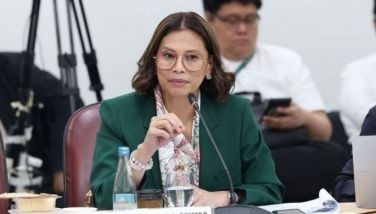Yearender: Action-packed year for AFP
It was an action-packed year for the military in its daunting task of bringing peace to Mindanao and neutralizing the enemies of the state.
Hell broke loose in early August when renegade factions of the Moro Islamic Liberation Front (MILF) went on a rampage in Central Mindanao, killing and wounding scores of defenseless villagers.
The rebels were angered by the botched signing of the Memorandum of Agreement on Ancestral Domain (MOA-AD), which could have placed almost half of Mindanao, including part of Palawan, under the control of the MILF’s Bangsamoro Juridical Entity.
Violence escalated when the military and the police came to the rescue of the embattled civilians.
As fighting continued, the government and the MILF leadership blamed each other for the crisis.
The new hostilities brought back memories of the bloody conflict between the government and the Moro National Liberation Front (MNLF) in the early 1970s.
The communist New People’s Army (NPA) then took the opportunity to launch tactical offensives against government troops in Mindanao, followed by small unit operations in Luzon and the Visayas.
The communist offensive forced the military under the leadership of Gen. Alexander Yano to fight on three fronts, including the Abu Sayyaf.
Costly war
Mobilizing about 70 percent of its strength, the military launched sea, air, and land assaults on locations in known MILF lairs in Central Mindanao provinces.
Targets of these operations were notorious MILF commanders Ameril Ombra Kato, Abdurahman Macapaar alias Commander Bravo, and Aleem Sulaiman Pangalian.
The operation to capture or eliminate the three MILF leaders proved too costly. The MILF leadership has refused to surrender them while the military continues to track them down at the expense of incurring more damages.
Official military figures showed that more than 40 soldiers were killed in action while more than a hundred more were wounded and maimed in the battlefield.
At the height of the campaign, the military lost one of its two remaining C-130 planes.
The Hercules plane crashed in flames in the Davao Gulf shortly after it took off from the Davao International Airport late August, killing all 13 on board.
Before the mishap, the ill-fated military transport plane had just ferried Scout Ranger troops from Fort Magsaysay, Nueva Ecija to Davao.
To date, not a single body was recovered from the plane’s wreckage that is still lying 200 to 400 meters underwater.
Airmen investigators would later blame bad weather for the mishap, dismissing suspicions of sabotage.
At the frontline, MILF casualties were reportedly higher but this could not be easily confirmed.
With rising casualty figures, year 2008 is the costliest in eight years of the military’s history.
For decades people of Mindanao have longed for peace but this has remained elusive.
Observers believe that corrupt or indifferent politicians are partly to blame for the elusive peace in the region.
The country may see more of the hopeless specter of people dying in battlefields or at evacuation centers.
With no end in sight to violence, the region has become a giant garrison where rights are often violated and where the weak suffer most.
When Kato and his armed brigand attacked villages in North Cotabato in the first week of August, scores of civilians were killed, including a 63-year-old woman who was executed by the rebels while kneeling and begging for her life.
In the last week of August, Macapaar and Pangalian attacked and pillaged five towns and nearby villages in Lanao del Norte, killing 28 people, including a policeman and an Army officer.
Condemnation
The government quickly condemned the attack and ordered swift military actions to restore order. The operation, however, displaced hundreds more families.
Aware that the military hunt for Kato, Macapaar and Pangalian would drain its operational budget, the Armed Forces of the Philippines (AFP), through Defense Secretary Gilberto Teodoro, asked Congress for additional P1.8 billion to bankroll its offensive against the rebels.
Yano is optimistic that the military can achieve and accomplish its mission this year with the new resources.
On the other hand, the government is also trying to remedy the situation by mending fences, not only with the MILF but also with the communist leaders, to bring them back to the negotiating table.
But realities on the ground speak otherwise. Time and again the MILF has declared that while it wants peace, it would not hesitate to resort to violence to achieve its goal of implementing the MOA-AD, insisting that it was already a “done deal.”
On the other hand, the communist leadership based in the Netherlands wants the Philippine government to negotiate with the US government and European Union to remove the NPA from their lists of foreign terrorist organizations.
Gaining headway
With superior air and land firepower, the military campaign in Mindanao against the notorious MILF leaders is gaining headway, although they are still at large.
In fact, the AFP leadership has announced that it is now scaling down its offensive against the three MILF leaders, who it now tags as belonging to LMGs (lawless Moro groups).
Unlike in the early stages of fighting where the rebels were capable of mounting company-sized and battalion-sized attacks, the MILF renegades are forced to resort to hit-and-run operations.
All things considered, prospects are really bleak for the defense and military establishments to bring peace in Mindanao and defeat the communist insurgents at the same time, which was described by President Arroyo as a stumbling block in her program of peace and development in the country.
Behind all these military gains is a sad reality that displaced families are growing.
Government figures showed 63,657 families or 312,332 people have been forced out of their homes.
Of these government figures, 15,472 families or 75,893 people are still staying in evacuation centers while 48,215 displaced families or 236,439 people are outside evacuation centers.
The cost of the war in terms of the humanitarian aspect has already reached more than P200 million, P49 million of which was provided by local and foreign non-government organizations while the balance was shouldered by the government.
The Department of Social Welfare and Development (DSWD), for its part, conceded the lack of resources to provide adequate help to evacuees.
The Department of Health (DOH), on the other hand, said immediate psychosocial rehabilitation should be provided to many evacuees, especially the elderly, women and children, due to trauma.
Both agencies are working directly under the DND’s National Disaster Coordinating Council (NDCC), which Teodoro, as defense chief, also heads.
Civilian fatalities are estimated at 200, but this figure does not include those who were caught in the crossfire or those who were simply picked up and immediately buried by their relatives or surviving family members.
The rising civilian casualties have worsened the animosity between Christians and Muslims in the region. Vigilantism is becoming a chilling concern.
“Sino ang dapat managot at sisihin sa giyerang ito (Who’s to blame for this war)?” asked a village leader from a farming community near Liguasan Marsh.
- Latest
- Trending



























